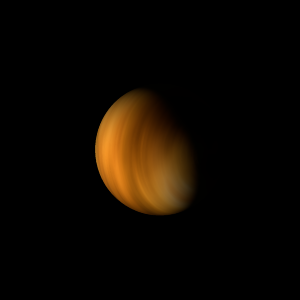|
|
Space Astro
|
Info for exoplanet "Kinber Robian"
| Scientific (actual) data |
|---|
| Name | CWISE J1015-1115 (AB)b |
| Planet status | Confirmed |
| Planet mass | 60 |
| Semi major axis | 5800 |
| Discovered | 2024 |
| Updated | 2024-07-29 |
| Publication | Published in a refereed paper |
| Detection type | Imaging |
| Mass measurement type | Spectrum |
| Alternate names | CWISE J101523.92-111539.6, CWISE J101533.05-111501.0 (AB)b |
| Star name | CWISE J1015-1115 |
| Right ascension | 153.89° |
| Declination | -11.25° |
| Star distance | 41.75 |
| Star metallicity | -0.7 |
| Star mass | 0.32 |
| Star sp type | M3V |
| Star age | 13 |
| Star alternate names | CWISE J101533.05-111501.0 |
| Wikipedia article | CWISE J1015-1115 (AB)b |
Back
| |
| Fictional info (?) |
|---|
| Suggested name | Kinber Robian |
| Planet type | Huge cold gas giant |
| As seen from CWISE J1015-1115, in a frame of reference that rotates with the orbital motion, it appears to rotate only once every two years.
It has the densest atmosphere of all the huge cold gas giants, consisting mostly of xenon. The atmospheric pressure at the planet's surface is 0.15 bar, or roughly the pressure found 1440 m under the oceans of Earth. It may have had ozone oceans in the past, but these would have vaporized as the temperature rose due to a runaway greenhouse effect. |
| Atmosphere | Xenon | 50% |
| Ammonia | 48% |
| Ozone | 1.5% |
| Ethane | 0.062% |
| Atmospheric pressure | 0.15 bar |
 |
| No known satellites |
| Google search for Kinber robian |
|
Website by Joachim Michaelis
|
|
|
|